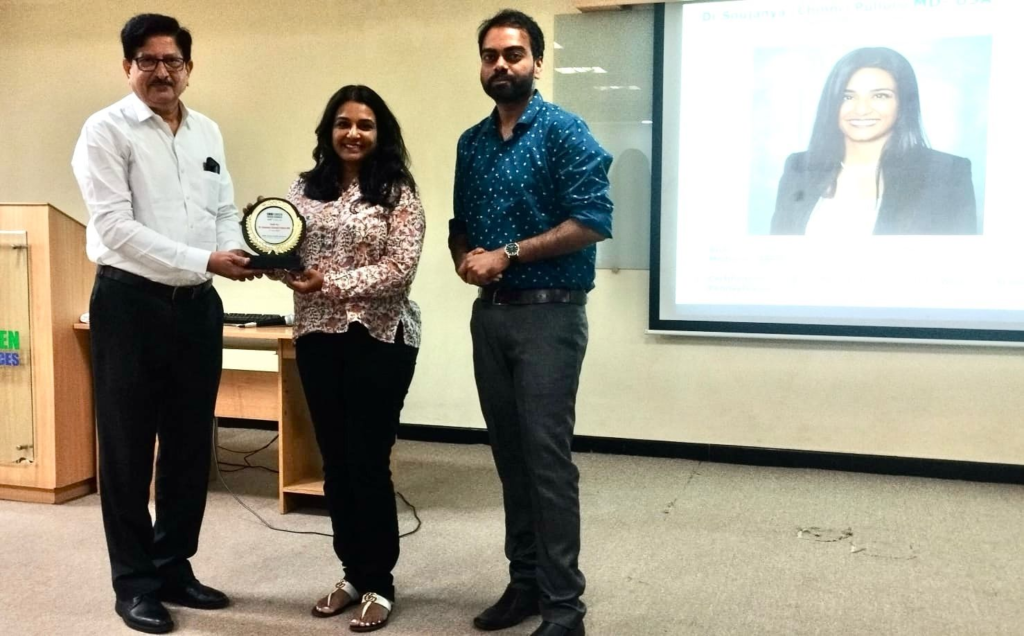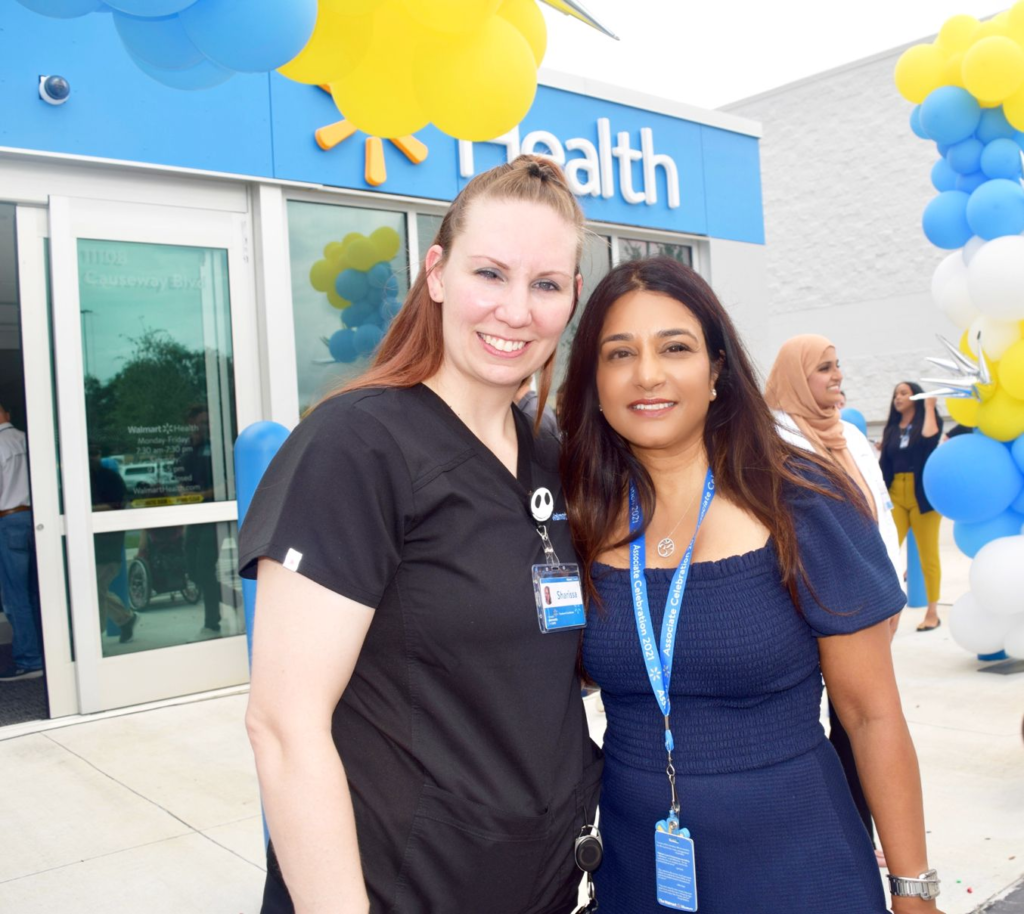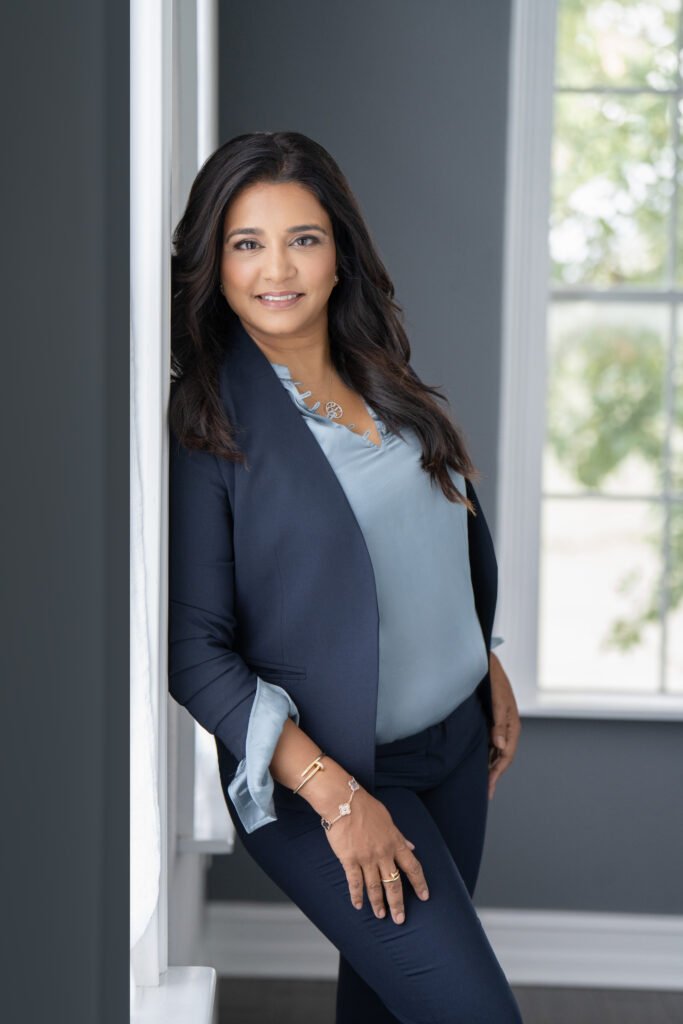Dr. Shabana Parvez, MD, FACEP,, US Bureau Chief of The Desi Buzz and founder of ArlingtonIntegrative.com, recently engaged in an enlightening conversation with Dr. Soujanya (Chinni) Pulluru, Chief Medical Officer (Fractional) at Stellar Health. In this insightful discussion, Dr. Parvez speaks with Dr. Pulluru, a seasoned healthcare leader with experience at My Precious Genes, PhysicianX, CareCo, and the U.S. Department of Health and Human Services (HHS), about the future of the U.S. healthcare system and the benefits of Value-Based Care (VBC). Dr. Pulluru shares valuable insights on how VBC can improve outcomes for both patients and providers, highlighting the importance of technology in making healthcare more accessible and affordable. She discusses her work in genetic counseling and healthcare innovation, as well as her contributions to national healthcare policy as Co-Chair of the Physician-Focused Payment Model Technical Advisory Committee (PTAC). This engaging dialogue offers valuable perspectives on building a more efficient, equitable, and patient-centered healthcare system. Don’t miss this insightful discussion!
Check out other interviews: https://thedesibuzz.com/category/interviews-editorial/
Watch the interview on YouTube
Dr Shabana Parvez: Welcome, Dr. Pulluru. Dr. Soujanya Susan Pulluru—she prefers to go by Chinni—is a visionary leader in sustainable healthcare. She’s known for her dedication to advancing value-based care and innovative healthcare solutions. She has founded several initiatives aimed at improving global health and is a passionate advocate for women’s and youth health. Dr. Pulluru actively serves on many advisory boards focused on wellness and sustainability. She’s committed to humanizing healthcare and is the incoming co-chair of the Physician-Focused Payment Model Technical Advisory Committee (PTAC), a Health and Human Services subcommittee that advises the Centers for Medicare & Medicaid Services (CMS). She has been re-elected to this position. Dr. Pulluru also served as Vice President and Chief Clinical Executive at Walmart. She is passionate about value-based care, and we’ll be discussing that and her amazing contributions to healthcare in the country today. Welcome, Dr. Pulluru.
Dr. Soujanya (Chinni) Pulluru: Thank you, Dr. Parvez. It’s a pleasure to be here.
Dr Shabana Parvez: Dr. Pulluru, your journey spans from India to the US. How did those experiences shape your perspective on healthcare?
Dr. Pulluru: Let me start with why I went into medicine. It’s been a part of my life since I was a child because my dad is a doctor. I grew up watching him practice medicine, especially in rural India when he would go back to visit, as well as in the US. So, it’s something I’ve always been a part of and fairly passionate about because I feel like it’s such a calling in a service industry. As for studying in India and then coming here, I grew up here and had gone back to study there because my parents had moved there at the time. When you see medicine practiced in India, it’s a very different perspective compared to what you bring to medicine here. Many physicians here who trained in India understand this. You’re trained in the art of clinical diagnosis. You’re trained in really understanding the depth of knowledge to the point that you can use that to have intuition and instinct. I think that’s been awesome, but it’s also been great for value-based care. In India, prior to recent years, all healthcare was cash pay. So, as a physician, you had to be very careful about how you spent the patient’s money. People couldn’t necessarily afford for you to just order tests because you wanted to see what they were, and it wasn’t necessarily malpractice-driven. So, it really teaches you to be very prudent in what you order, and that’s the principle of value-based care. Seeing practice in both India and the US gave me a broader view. In India, the emphasis was on clinical diagnosis, resourcefulness, and understanding the patient’s financial constraints due to the cash-pay system. This instilled a deep appreciation for value-based care, even before it was formally defined. It taught me prudence in ordering tests and focusing on the patient’s needs first.

Dr Shabana Parvez: What’s the biggest change you’ve witnessed in primary care over the last two decades?
Dr. Soujanya (Chinni) Pulluru: The biggest change is the shift from independent practices to large, employed groups. While consolidation offers some benefits, it has also increased administrative burdens, decreased physician autonomy, and negatively impacted job satisfaction. The joy of medicine has been diminished by the sheer volume of paperwork. Physicians are spending more time charting than with patients. When I started in this field, physicians owned their practices and had a level of ownership and autonomy that came with it. Now, about 75% of physicians are employed by large organizations. Some of that is necessary due to industry consolidation. However, to our detriment, the biggest change is the increased administrative burden physicians face. We’ve always worked hard—residency is hard, our parents worked hard—so it’s not a matter of the number of hours or how hard we’re willing to work. The issue is that the joy of medicine has changed. When you spend 15 minutes face-to-face with a patient and then spend half an hour charting, that’s not what we signed up for.

Dr Shabana Parvez: That’s a good point. It’s one of the reasons I left the traditional path to regain some autonomy. Do you think the industrialization and corporatization of healthcare has affected patient care, physician well-being, or healthcare spending? Who does it benefit most: patients, physicians, or corporations?
Dr. Soujanya (Chinni) Pulluru: It’s a give and take. It’s become necessary due to the level of regulation and administrative work involved, even with billing a single patient. Individual physicians need the purchasing power of larger groups to function efficiently. However, it’s not ideal for physicians. It has led to demoralization and moral injury because they no longer own their practices. Many groups are trying to give physicians autonomy in how they practice. When physicians tell me they want autonomy, I ask, “Autonomy in what?” Do they want autonomy in training their front office staff, or in how they practice medicine and manage their schedules? Usually, it’s the latter. Many physicians still have that, but…

Dr Shabana Parvez: …purchasing power, yeah.
Dr. Soujanya (Chinni) Pulluru: On the positive side, we have access to much more patient data, which can drive better care. On the negative side, clinicians have to wade through a lot more data. It’s a mixed bag. There are positive and negative aspects to both sides. Overall, it’s made things very difficult for physicians.

Dr Shabana Parvez: Let’s talk about value-based care. Can you explain what it is and share your experience leading a large independent multi-specialty physician group in promoting it? What strategies did you use to engage physicians, and how did you balance the needs of physicians, patients, and the business aspect?
Dr. Soujanya (Chinni) Pulluru: That’s a complex topic! Value-based care changes the payment mechanism. Instead of fee-for-service, where you’re only paid when a patient comes through your door, you’re reimbursed for keeping patients healthy. Imagine a diabetic patient. In a fee-for-service model, you’re only paid when they come in. In value-based care, you receive a certain amount per month to care for that patient and keep them healthy. Now, you can spend time reviewing their chart, calling them to ensure they’re taking their medication, or even hire someone to do that. Ultimately, it leads to better outcomes and more physician satisfaction because you’re not tied to the “hamster wheel.” You can invest resources in different ways of caring for a patient.

In order to have a sustainable practice, you end up having to see a lot of patients because that’s the only way you get reimbursed. In value-based care, especially in primary care, you’re reimbursed for keeping the patient healthy. Imagine that same diabetic patient comes in, and I’m getting a certain amount per month to care for that patient and keep them healthy. Now I can actually spend the time to look at their chart, call them, make sure they picked up their medicine, or even hire someone to do that because I can afford it. Ultimately, it leads to better outcomes, and I believe it leads to a lot more satisfaction from the physician’s perspective because you’re not tied to this “hamster wheel.” You can actually invest resources in caring for a patient differently.

Dr Shabana Parvez: So, you’ve found that both physicians and patients are more satisfied with this system?
Dr. Soujanya (Chinni) Pulluru: I think it’s the trend. The transformation to it is difficult for physicians because it’s a different way of thinking. Often, it’s implemented in environments where they have to do both fee-for-service and value-based care, which makes it hard. It becomes a delicate balance. Sometimes they don’t have the right data, or sometimes, you know, we’re saying, “We’ll pay you to take care of a patient holistically,” but you get no other resources, like, “We’re not going to hire you a nurse,” or “We’re not going to hire you…” So, that’s difficult because you’re not really equipping physicians to do what they’re best at, and taking away some of the other things… Community health workers are really good at figuring out community resources and how to help a patient get what they need. That’s not what I know.

Dr Shabana Parvez: Right, yeah. Unfortunately, that’s fallen a lot on primary care physicians who try to do all those things.
Dr. Soujanya (Chinni) Pulluru: Exactly. So, I think when it’s done correctly, and physicians get to the other side of it, they’re actually happier and better compensated. There’s more job satisfaction, smaller panels, and patients tend to be happier. Patients love the fact that their office noticed they didn’t pick up their meds or that they didn’t… They care enough about me. You start to see these testimonials from patients. So, I do think it’s a much better system, which is why I’ve invested most of my professional career in it.
Dr Shabana Parvez: What are your thoughts on private equity in healthcare?
Dr. Soujanya (Chinni) Pulluru: Private equity isn’t inherently negative. It brings resources and operational efficiency but must be managed carefully to avoid excessive intrusion into clinical decisions. When done right, it can help practices grow sustainably. People demonize private equity.
Dr Shabana Parvez: Yeah.
Dr. Soujanya (Chinni) Pulluru: And I don’t necessarily believe it’s all merited. I think it has to do with how much operational intrusion they have. One thing private equity does is force you to be very precise in how you deploy resources and careful in how you manage money. Those are things we should be doing anyway, because we have to earn the right to be sustainable. A practice is ultimately a business, and we’re all business owners when we own our practice. It’s not charity; it’s a business. If we want it to be charity, we define it as such separately. Private equity forces you to acknowledge that and say, “We have to deploy resources in a way that we’re going to be sustainable.” Second, they bring resources to the table. When our private equity group bought us, they brought in people who knew what to do with data, national experts on certain things that we wouldn’t have had access to. They upped our game that way. The difficult part is the potential for operational intrusion. That’s something you have to negotiate. Sometimes decisions are made without an understanding of how medicine is practiced.

Dr Shabana Parvez: Mm-hmm, yes.
Dr. Soujanya (Chinni) Pulluru: Or there’s a change in leadership. They’ll bring in people with amazing resumes, “superstars,” but they don’t understand the ground level, the magic that made the group successful in the first place. You have to manage it carefully. I don’t feel private equity is negative; you just have to manage it a certain way. It can help a group become sustainable and grow, versus making it very difficult for physicians. It all needs to be negotiated upfront.

Dr Shabana Parvez: Mm-hmm, that’s true. Good point. Tell us about your experience at Walmart as Chief Clinical Executive. You were responsible for coordinating primary and dental care in many states. What innovations or lessons from that experience are impactful for the future of healthcare?
Dr. Soujanya (Chinni) Pulluru: I loved working for Walmart. It’s a phenomenal company with phenomenal leadership. I learned a lot about how customer-focused they are, how patient-focused they made us be. They are very consumer-centric, very patient-centric. We taught very specific language to our receptionists and staff, best practices we learned from companies like Disney. Everything we did was consumer-focused, and our net promoter score was 80, unheard of in healthcare. That lesson will be huge if I ever set up shop again: that singular focus on the patient, their feelings, what the customer wants, and listening to them. Walmart is also very good at scaling. We built clinics in six weeks to two months—from permitting to going live. Our testing centers went from one to over 600 in a few months during COVID. The way they operate and scale…
Dr Shabana Parvez: That’s incredible. Six weeks—wow!
Dr. Soujanya (Chinni) Pulluru: And they do it with such exactness and precision. It’s because everything is documented; nothing depends on one person’s memory. Everything is replicable and standardized. Healthcare can really learn from that.
Dr Shabana Parvez: Okay, that’s a good point. Standardized protocols make you more scalable.
Dr. Soujanya (Chinni) Pulluru: Yeah, and they’re willing to make mistakes. They test things, pilot things, make mistakes, and fail fast. One of my favorite things about Walmart was after our clinic launches. We’d have our Day 1 launch, our Day 2 launch, and then these “correction of errors” meetings, called “meeting cos,” at 5 or 6 pm because people in the field needed to attend. There would be 100 people in this meeting, and it didn’t matter who you were in the hierarchy; everyone spoke up about what went wrong.
Dr Shabana Parvez: That’s awesome.
Dr. Soujanya (Chinni) Pulluru: Yeah.
Dr Shabana Parvez: Their value-based care and senior health initiatives—did those improve care?
Dr. Soujanya (Chinni) Pulluru: It shifted their business model to be more focused on senior care. We hired and developed clinics focused on that. We enjoyed working with UnitedHealthcare and Optum; they brought a lot to the table. Unfortunately, that program didn’t get to live and mature because Walmart pulled back. But when it was working, it was great. Walmart has a high percentage of seniors who walk into their stores, so it was a natural partnership.
Dr Shabana Parvez: Mm-hmm, yeah. Let’s shift gears a bit. Tell us about My Precious Genes. What do you do in terms of genomics, and what are your opinions on gene sequencing and testing?
Dr. Soujanya (Chinni) Pulluru: Genetic testing and genomics will drive healthcare in the future. Ten years from now, we’ll practice medicine very differently. I co-founded My Precious Genes because, right now, over 90% of cancer therapies are driven by genetic testing, as are prenatal and infertility treatments. Think about cardiology—hypertrophic cardiomyopathy, other syndromes—there’s a genetic basis. There’s a vast amount of under-testing. For example, with pancreatic cancer genes, it’s 1 in 10. It’s important to understand your genetics and risk profile. In a value-based care world, imagine you’re a provider. Patient A has high blood pressure but no other risks. Patient B has high blood pressure, but their genetic sequencing shows a 4 or 8x risk for heart failure. Wouldn’t you treat Patient B’s blood pressure more aggressively? You’d keep it under tighter control, probably do an echocardiogram sooner. You’d treat them differently. That’s good because you get better outcomes. Precision medicine, genome sequencing, and genetic counseling (which is what we do—we don’t do the testing, but we recommend the best tests) are the future.

Dr Shabana Parvez: What do you say to those who are scared about privacy issues related to genome access? They worry about insurance premiums going up if their genetic risks are known.
Dr. Soujanya (Chinni) Pulluru: So much of our lives is already out there. 23andMe has sequenced 130 million Americans’ genomes. It’s out there. These things fall under HIPAA and bio-material protections; you can’t transport it internationally. There are protections in place regarding your employer or insurance company having access. It’s the same as anything else in your medical history. Pre-existing conditions don’t count right now. But I think there will be regulatory hurdles we’ll have to look at as this becomes more pervasive. Right now, it’s disease-specific. We know you have this disease, and we’re just doing testing, or we know your family has this disease. But as time goes on, we’ll have to look at the ethics and regulatory guardrails.
Dr Shabana Parvez: Where do you think, at what level, or who will take the lead on addressing these privacy concerns around genetic information? Will it be at the governmental level, and if so, which level of regulation—federal or state? What kind of agency might be involved?
Dr. Soujanya (Chinni) Pulluru: It will likely involve regulatory agencies like the FDA or other government bodies. Right now, there are rules about what information your doctor can share with your employer. Those rules should cover this testing as well. But as time goes on, and things become more complex, especially concerning wellness information, we’ll have to see. Even if you go to an employer health clinic, your employer doesn’t have access to your blood pressure readings, for example.
Dr Shabana Parvez: Mm-hmm.
Dr. Soujanya (Chinni) Pulluru: And they can’t make decisions based on those readings.
Dr Shabana Parvez: Right, that’s true. What are your thoughts on technology in healthcare? What gaps do you think technology can help address, and what other gaps do you see in our healthcare system? You’ve been an advisor and board member for many healthcare organizations and private companies, so how do you think technology can bridge the gaps?
Dr. Soujanya (Chinni) Pulluru: I think we should view technology not as a replacement for doctors or providers, but as a tool to make us more precise, efficient, and better able to reach and engage patients. For example, instead of giving a physician 100 data points before they walk into a room, technology can surface the 3 to 5 data points that really matter in that moment. This changes the physician’s focus. As we expand the care team with nurse practitioners, PAs, RNs, and community health workers, technology can be used to divide labor effectively, expanding the scope of what a physician can handle. We know there’s a physician shortage, and it’s getting worse. We’ll need other allied professionals as part of the care team. Technology can play a huge role in leveraging their skills. Currently, only about 20-24 cents of every healthcare dollar goes to pay physicians (and that includes all care providers—primary, specialty, everyone involved in care). About 60 cents goes to administrative costs. Think of what technology can cut out: coding review experts, people who manually handle bills, and so on. This reduces the cost of care and leaves more money to pay physicians and support staff like community health workers, physician assistants, and RNs.
Dr Shabana Parvez: You’ve talked about trends in healthcare, and it’s clear that the system is still top-heavy in terms of administrative and bureaucratic burdens. In your role, do you plan to take an active part in reducing that gap and diminishing the administrative burden?
Dr. Soujanya (Chinni) Pulluru: I hope so. We’re an advisory committee that advises the Secretary and works with CMMI and CMS. We hope to bring together thought leadership and surface concerns and barriers from people in the trenches. We explicitly bring people to the table—those doing the real work, leading large and small groups—who understand how policy affects people when it’s implemented. You might have good intentions when you create policy, but those intentions don’t always play out as intended. One thing the committee does well is bring these perspectives, from those in the trenches along with academics, to Washington. We say, “Let’s look at what we’ve done. These things are well-intentioned, but there are unintended consequences. Maybe we can design better by listening to these folks.” I hope to play a part in that. I’m the current co-chair, and I hope to continue advising and shaping policy.
Dr Shabana Parvez: I wish you the best of luck in that. We definitely need that kind of change. With all the work you do, how do you manage your professional commitments and personal life? You’re a mom of three, right? How do you maintain your own well-being?
Dr. Soujanya (Chinni) Pulluru: I’m a fan of Indra Nooyi, and she said, “You don’t really balance; you’re out of balance.” It’s about figuring out where you compromise. I used to tell people my kids’ birthdays meant a cake from Costco; I didn’t have custom-made cakes with their names on the brownies. My kids knew that was how it was going to be. I tried my best, but you have to be okay with the compromises you make, your family makes, and your husband makes because you’re working and dedicating time to this. They also benefit from it. The important thing is to be there as much as you can for your children. Be clear about what’s most important. I used to tell my kids, “I won’t be at every practice, but I’ll come to these games, or I’ll be there for these important things.” I’d tell them, “If something is very important to you, let me know so I can put it on my schedule and make sure I’m there.” I didn’t have that luxury of perfect balance. Sometimes, as a woman, you make those compromises.
Dr Shabana Parvez: What would you say is your secret to success? What has driven and motivated you?
Dr. Soujanya (Chinni) Pulluru: I think it’s the constant ability to learn and grow. What I do now isn’t what I formally set out to do. Every few years, there’s a complete turnaround in what I know. Constantly putting yourself in a position to learn, rethink, and retest your assumptions is crucial. I always tell people I have the “right to get smarter” because you constantly have to reinvent yourself. That’s probably what’s helped me most. I’ve learned from everyone around me—from operational people at Walmart, my executive assistant (I learned Excel from her!), everyone.
Dr Shabana Parvez: That’s great advice—to continually be willing to learn. No one knows everything, so you have to keep learning. In my own practice, I’ve continually changed and transitioned, learning new things as knowledge in healthcare and medicine evolves.
Dr. Soujanya (Chinni) Pulluru: Yes.
Dr Shabana Parvez: Healthcare is undergoing rapid transformation. What’s your vision for the future of value-based care and healthcare in the next decade?
Dr. Soujanya (Chinni) Pulluru: I hope everyone is in some form of value delivery system, benefiting both physicians and payers. I hope it’s less painful for physicians. With technology, we can better allocate resources to patients who need them most and keep patients engaged. We spend so much money and keep trying harder, but the country is getting unhealthier. There’s a disconnect. We need to leverage what the rest of the world has found out in population health and what other industries have discovered in technology and bring it to healthcare. We can’t be afraid to change; we have to be bold because people are getting unhealthier.
Dr Shabana Parvez: As emerging healthcare leaders, what advice would you give them to make this impact? We’re spending more, yet getting unhealthier. How do we bridge that gap? How do we improve healthcare equity and patient outcomes?
Dr. Soujanya (Chinni) Pulluru: I have two pieces of advice. First, remember your role is to focus on the patient. I always say, “Patient first, physician (or provider) second.” If you’re not focusing on why you’re there in the first place, you’ve already lost. Second, don’t be afraid to rethink old norms. If you do things just because you’ve always done them that way, ask “why?” We used to make patients come in during banker’s hours and wait an hour, sometimes two, but wouldn’t see them if they were 10 minutes late. How does that make sense? As a healthcare leader, be willing to rethink and pressure-test why you have to do something a certain way. Just because someone did it that way in the past doesn’t mean it’s the right way.
Dr Shabana Parvez: How do you find creative outlets? Do you play an instrument, or how do you de-stress? Do you ever just go to a rock concert?
Dr. Soujanya (Chinni) Pulluru: I do! I love the sun, sunshine, and beaches. I love to read, though I don’t get to read as much historical fiction or other things as I’d like because I’m usually reading medical or policy stuff these days. I probably need to do more of that, but it’s amazing to read historical fiction, history, or even biographies of people in the past and learn how they made decisions, what tested them. You learn a lot from that.
Dr Shabana Parvez: You do, and there’s nothing wrong with that. I love it. Many young people are hesitant to move into leadership positions. What advice would you give to young people watching this who might be scared or unsure about taking on leadership roles, especially in healthcare?
Dr. Soujanya (Chinni) Pulluru: Be bold and take risks. We’re privileged. I grew up with a dad who’s a physician, and we’re privileged to have the choices we have—to live where we do and get an education, particularly if you’re a woman. Be bold, take chances. I just told my son this morning, “The world should be a better place because you lived.”
Dr Shabana Parvez: That’s good advice. How can people learn more about you or connect with you?
Dr. Soujanya (Chinni) Pulluru:LinkedIn is always great. It has my contact information. Reach out to me there; I’m always open to talking and meeting people. I’m an extrovert, so it gives me energy to meet people.
Dr Shabana Parvez: Great.

Dr. Soujanya (Chinni) Pulluru: I’m impressed by the brilliant founders and entrepreneurs I’ve met who are coming up with solutions. They don’t have to be large-scale; even small solutions that get adopted by a slightly larger group, and then a slightly larger group, can create big change. I’m very optimistic. Between genetics, AI, and the brilliant, energetic people I’ve seen committed to improving healthcare, I think it will all come together eventually.
Dr Shabana Parvez: I agree.
Dr. Soujanya (Chinni) Pulluru: But it should partner with a clinical lens. We have to keep the patient in mind.
Dr Shabana Parvez: Absolutely. I think a key focus needs to be on wellness and preventative care, not just illness and sick care. We really need to transition to that.
Dr. Soujanya (Chinni) Pulluru: Yes, focus on how people live their lives.
Dr Shabana Parvez: Exactly, lifestyle. I’m hopeful we’ll see more change in that direction, and that you’ll be at the forefront of that change. It was wonderful talking to you, Chinni. I wish you all the best. I’m excited about the future.
Dr. Soujanya (Chinni) Pulluru: Thank you, Shabana. Same here. Thank you for having me.

